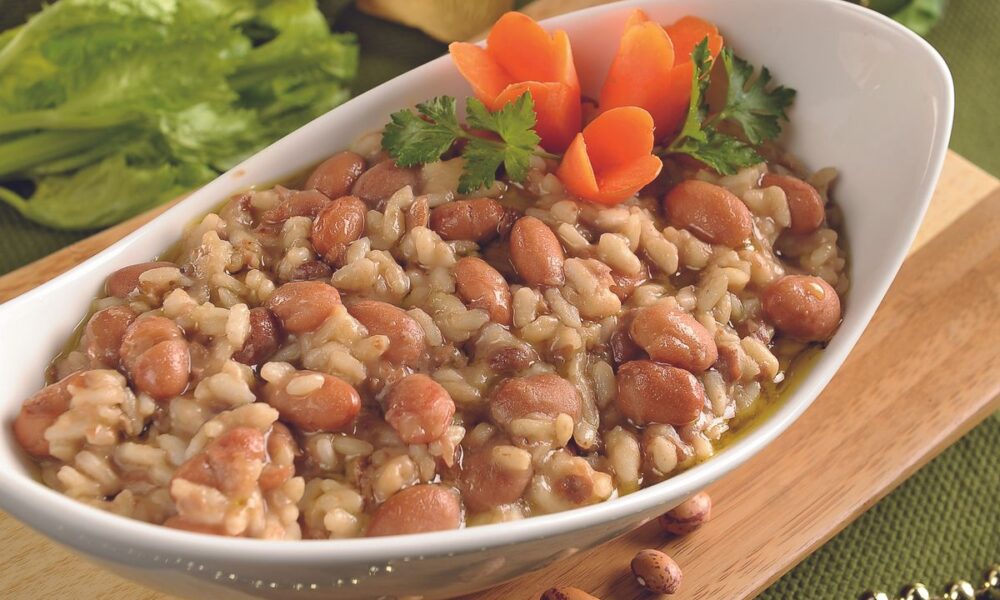Recipes
Panissa Vercellese: the original recipe for the first course from Piedmont

The traditional recipe for Piedmontese panissa is that of an easy first course, made with typical ingredients: rice, beans, duja salami and little else.
Vercellese panissa is a delicious first course, whose name changes depending on the province in which it is prepared. However it is identified, this is a typical product of Piedmont, linked to an ancient tradition. Before presenting it, it is important to point out that this recipe should not be confused with the Ligurian preparation of the same name. The one originally from Vercelli is a rice -based first course. The seasoning is particular and enriched with products linked to the territory, such as beans .
Furthermore, the duja salami (basically the one in fat) cannot be missing. The latter is a particular sausage, which is left to mature in terracotta jars, filled with lard, and which enriches the whole dish with flavour.
Preparing the panissa recipe
- The evening before, soak in Saluggia beans (alternatively Borlotti beans) in plenty of water.
- The following morning, prepare the bean broth , bruüra di fasö' in the local dialect. Place the beans, half the duja salami and the water in a pan and leave to cook for at least 2 hours. The beans should be tender. Add salt only at the end.
- When preparing the panissa, chop the onion and lard and cut the remaining salami into pieces. Brown everything in the pan without adding any more fat.
- Add the rice and toast it then add the drained beans , the boiled and crumbled salami and add the red wine .
- Pour in the tomato puree and start cooking the rice by adding bean broth little by little, just as you usually do with risotto. It will take approximately 16-18 minutes of cooking depending on the variety of rice used.
Here is a video where you can see all the steps to make this first course, poor but very rich in flavor as well as very substantial.
Alternatively, for a tasty first course we also recommend the Barolo risotto .
The real name of panissa and how to taste it
Originally from the Vercelli area, this first course is also called Piedmontese paniccia. The traditional preparation has spread to other nearby provinces, but with different names and some changes in the recipe. In upper Lomellina and Novarese it is known as paniscia and prepared with other vegetables, such as cabbage and cabbage . The same name is used in some areas of Lombardy. In the provinces of Lodi and Pavia, the use of beans is not foreseen, but grated Grana Padano is added.
Another curiosity is linked to the real Panissa recipe. Traditionally, after serving the dish at the table, a pit was created in the center of the rice, to pour more wine and give even more flavor to the preparation. The product must be red and full-bodied, such as Nebbiolo or Barbera (also used as a wine pairing with Panissa from Vercelli). However, this custom is slowly disappearing among the provinces concerned. The habit that has not been lost, however, is that of flavoring the dish with grated cheese.
Conservation
Once ready, the Vercellese panissa can be stored in the fridge , closed in an airtight container, for 2 days . You can heat it if necessary.
Origin and history
A Piedmontese proverb states "Rice is born in water and dies in wine" and this is especially true for panissa of which, among other things, there is also a brotherhood . We have already seen above how to enjoy it in the ancient way, with wine at the centre, but what is the history of this dish? To understand it we need to take a step back in time to when rice arrived in the Vercelli area thanks to the Cistercian monks. At that time, however, the concept of risotto did not exist: rice soups were served which only with the passage of time became "dry" and transformed into the dish we know today.
Piedmontese panissa is one of these. It owes its name to panìcum , a cereal similar to millet used since the Middle Ages instead of rice. Subsequently, rice began to be cooked but kept separate from the beans, which were served as an accompaniment after being sautéed in a pan with lard.
As with other traditional recipes, even in this case it is difficult to identify the original . However, there are some basic ingredients typical of the area such as rice, excellent Sant'Andrea and Vialone Nano ; Saluggia beans (which can be replaced by borlotti beans); unflavoured lard ; the salami d'la doja , a salami that is matured in terracotta containers filled with lard.
Riproduzione riservata © - WT